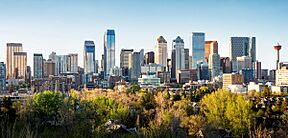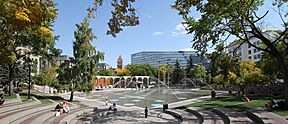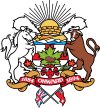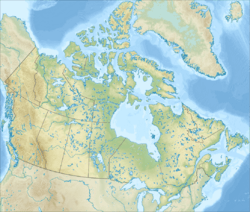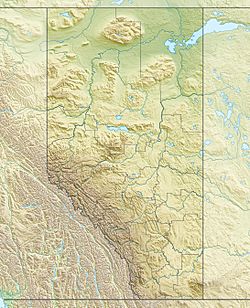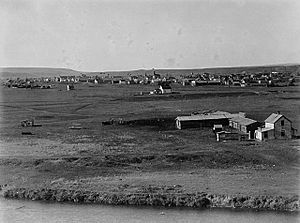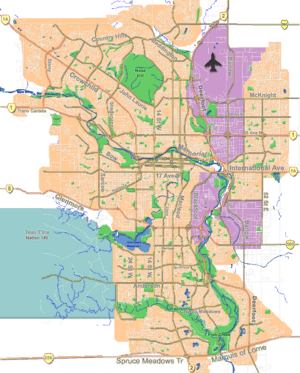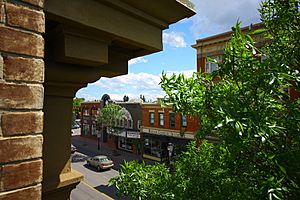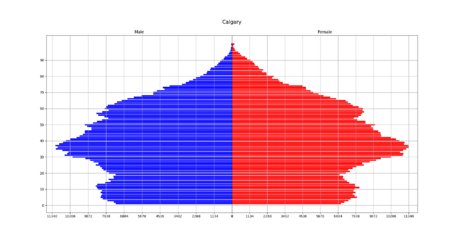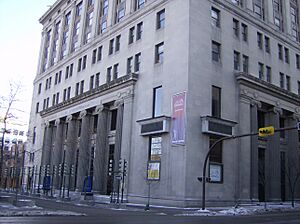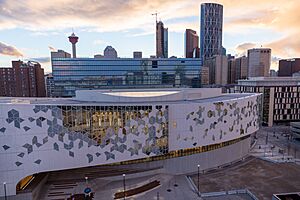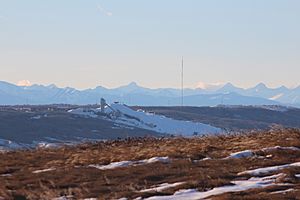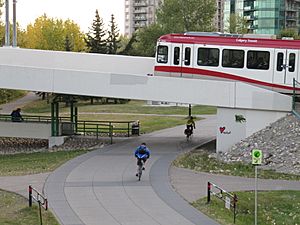Calgary facts for kids
Quick facts for kids
Calgary
|
|||||
|---|---|---|---|---|---|
| City of Calgary | |||||
|
Skyline of Downtown Calgary
Olympic Plaza
Calgary Stampede Rodeo
|
|||||
|
|||||
| Nicknames:
The Stampede City, Cowtown, Mohkínstsis, Wîchîspa Oyade, Guts’ists’i more...
|
|||||
| Motto(s):
Onward
|
|||||
| Country | Canada | ||||
| Province | Alberta | ||||
| Region | Calgary Metropolitan Region | ||||
| Census division | 6 | ||||
| Municipal districts | Rocky View County and Foothills County | ||||
| Founded | 1875 | ||||
| Incorporated | |||||
| • Town | November 7, 1884 | ||||
| • City | January 1, 1894 | ||||
| Named for | Calgary, Mull | ||||
| Government | |||||
| • Body | Calgary City Council | ||||
| Area
(2021)
|
|||||
| • Land | 820.62 km2 (316.84 sq mi) | ||||
| • Urban | 621.72 km2 (240.05 sq mi) | ||||
| • Metro | 5,098.68 km2 (1,968.61 sq mi) | ||||
| Elevation | 1,045 m (3,428 ft) | ||||
| Population
(2021)
|
|||||
| • City | 1,306,784 (3rd) | ||||
| • Density | 1,592.4/km2 (4,124/sq mi) | ||||
| • Urban | 1,305,550 (4th) | ||||
| • Urban density | 2,099.9/km2 (5,439/sq mi) | ||||
| • Metro | 1,481,806 (5th) | ||||
| • Metro density | 290.6/km2 (753/sq mi) | ||||
| Demonym(s) | Calgarian | ||||
| Time zone | UTC−07:00 (MST) | ||||
| • Summer (DST) | UTC−06:00 (MDT) | ||||
| FSAs |
T1Y, T2A - T3S
|
||||
| Area code(s) | 403, 587, 825, 368 | ||||
| NTS Map | 082O01 | ||||
| GNBC Code | IAKID | ||||
| GDP (Calgary CMA) | CA$102.66 billion (2020) | ||||
| GDP per capita (Calgary CMA) | CA,885 (2022) | ||||
Calgary is the largest city in the Canadian province of Alberta. It is the largest metro area within the three prairie provinces. As of 2021, the city proper had a population of 1,306,784 and a metropolitan population of 1,680,000 making it the third-largest city and fifth-largest metropolitan area in Canada.
Calgary is at the confluence of the Bow River and the Elbow River in the southwest of the province, in the transitional area between the Rocky Mountain Foothills and the Canadian Prairies, about 80 km (50 mi) east of the front ranges of the Canadian Rockies, roughly 299 km (186 mi) south of the provincial capital of Edmonton and approximately 240 km (150 mi) north of the Canada–United States border. The city anchors the south end of the Statistics Canada-defined urban area, the Calgary–Edmonton Corridor.
Calgary's economy includes activity in many sectors: energy; financial services; film and television; transportation and logistics; technology; manufacturing; aerospace; health and wellness; retail; and tourism. The Calgary Metropolitan Region is home to Canada's second-largest number of corporate head offices among the country's 800 largest corporations. In 2015, Calgary had the largest number of millionaires per capita of any major Canadian city. In 2022, Calgary was ranked alongside Zürich as the third most livable city in the world, ranking first in Canada and in North America. In 1988, it became the first Canadian city to host the Olympic Winter Games.
Contents
Etymology
Calgary was named after Calgary Castle (in Scottish Gaelic, Caisteal Chalgairidh) on the Isle of Mull in Scotland. Colonel James Macleod, the Commissioner of the North-West Mounted Police, had been a frequent summer guest there. In 1876, shortly after returning to Canada, he suggested its name for what became Fort Calgary. The Scottish Gaelic placename Calgairidh, in turn, possibly originates from a compound of kald and gart, Old Norse words, meaning "cold" and "garden". If so, the placename is likely a relic of Norse settler-colonists who occupied the Inner Hebrides in the medieval period. A competing etymology cites the Gaelic cala[dh] gàrraidh, which means "enclosed meadow (or pasture) harbour", or, alternatively, cala[dh]-gheàrraidh, meaning "harbour pasture". The first of these two possibilities, arguably translatable as "meadow harbour", has some relevance to local geography: the town of Calgary, such as it is, has a large meadow to its east, and this meadow leads to Calgary beach.
The name of the city serves as a shibboleth, as residents correctly pronounce the name with two syllables, /ˈkælɡriː/ KAL-gree, while others mistakenly pronounce it /ˈkælɡəri/ kal-GƏR-ee.
The Indigenous peoples of Southern Alberta refer to the Calgary area as "elbow", in reference to the sharp bend made by the Bow River and the Elbow River. In some cases, the area was named after the reeds that grew along the riverbanks, reeds that had been used to fashion bows. In the Blackfoot language (Siksiká) the area is known as Mohkínstsis akápiyoyis, meaning "elbow many houses", reflecting its strong settler presence. The shorter form of the Blackfoot name, Mohkínstsis, simply meaning "elbow", is the popular Indigenous term for the Calgary area. In the Nakoda or Stoney language, the area is known as Wîchîspa Oyade or Wenchi Ispase, both meaning "elbow". In the Cree language, the area is known as otôskwanihk (ᐅᑑᐢᑿᓂᕽ) meaning "at the elbow" or otôskwunee meaning "elbow". In the Tsuutʼina language (Sarcee), the area is known as Guts’ists’i (older orthography, Kootsisáw) meaning "elbow". In Kutenai language, the city is referred to as ʔaknuqtapȼik’. In the Slavey language, the area is known as Klincho-tinay-indihay meaning "many horse town", referring to the Calgary Stampede and the city's settler heritage.
There have been several attempts to revive the Indigenous names of Calgary. In response to the Truth and Reconciliation Commission of Canada, local post-secondary institutions adopted "official acknowledgements" of Indigenous territory using the Blackfoot name of the city, Mohkínstsis. In 2017, the Stoney Nakoda sent an application to the Government of Alberta, to rename Calgary as Wichispa Oyade meaning "elbow town"; however, this was challenged by the Piikani Blackfoot.
History
Etymology
Calgary was named after Calgary on the Isle of Mull, Scotland. In turn, the name originates from a compound of kald and gart, similar Old Norse words, meaning "cold" and "garden", likely used when named by the Vikings who inhabited the Inner Hebrides. Alternatively, the name might be Gaelic Cala ghearraidh, meaning "beach of the meadow (pasture)"; or Gaelic for either "clear running water" or "bay farm".
First settlement
The Calgary area was inhabited by pre-Clovis people whose presence has been traced back at least 11,000 years. Before the arrival of Europeans, the area was inhabited by the Blackfoot, Blood, Peigan and the Tsuu T'ina First Nations peoples, all of which were part of the Blackfoot Confederacy. In 1787, cartographer David Thompson spent the winter with a band of Peigan encamped along the Bow River. He was a Hudson's Bay Company trader and the first recorded European to visit the area. John Glenn was the first documented European settler in the Calgary area, in 1873.
The site became a post of the North-West Mounted Police (now the Royal Canadian Mounted Police or RCMP). The NWMP detachment was assigned in 1875 to protect the western plains from US whisky traders, and to protect the fur trade. Originally named Fort Brisebois, after NWMP officer Éphrem-A. Brisebois, it was renamed Fort Calgary in 1876 by Colonel James Macleod.
When the Canadian Pacific Railway reached the area in 1883, and a rail station was constructed, Calgary began to grow into an important commercial and agricultural centre. Over a century later, the Canadian Pacific Railway headquarters moved to Calgary from Montreal in 1996. Calgary was officially incorporated as a town in 1884, and elected its first mayor, George Murdoch. In 1894, it was incorporated as "The City of Calgary" in what was then the North-West Territories. The Calgary Police Service was established in 1885 and assumed municipal, local duties from the NWMP.
The Calgary Fire of 1886 occurred on November 7, 1886. Fourteen buildings were destroyed with losses estimated at $103,200. Although no one was killed or injured, city officials drafted a law requiring all large downtown buildings to be built with Paskapoo sandstone, to prevent this from happening again.
After the arrival of the railway, the Dominion Government started leasing grazing land at minimal cost (up to 100,000 acres (400 km2) for one cent per acre per year). As a result of this policy, large ranching operations were established in the outlying country near Calgary. Already a transportation and distribution hub, Calgary quickly became the centre of Canada's cattle marketing and meatpacking industries.
By the late 19th century, the Hudson's Bay Company (HBC) expanded into the interior and established posts along rivers that later developed into the modern cities of Winnipeg, Calgary and Edmonton. In 1884, the HBC established a sales shop in Calgary. The HBC also built the first of the grand "original six" department stores in Calgary in 1913, the others that followed are Edmonton, Vancouver, Victoria, Saskatoon, and Winnipeg.
Between 1896 and 1914 settlers from all over the world poured into the area in response to the offer of free "homestead" land. Agriculture and ranching became key components of the local economy, shaping the future of Calgary for years to come. The world-famous Calgary Stampede, still held annually in July, was started by four wealthy ranchers as a small agricultural show in 1912. It is now known as the "greatest outdoor show on earth".
Oil boom
Oil was first discovered in Alberta in 1902, but it did not become a significant industry in the province until 1947 when reserves of it were discovered near Leduc. Calgary quickly found itself at the centre of the ensuing oil boom. The city's economy grew when oil prices increased with the Arab Oil Embargo of 1973. The population increased by 272,000 in the eighteen years between 1971 (403,000) and 1989 (675,000) and another 345,000 in the next eighteen years (to 1,020,000 in 2007). During these boom years, skyscrapers were constructed and the relatively low-rise downtown quickly became dense with tall buildings.
Calgary's economy was so closely tied to the oil industry that the city's boom peaked with the average annual price of oil in 1981. The subsequent drops in oil prices were cited by industry as reasons for a collapse in the oil industry and consequently the overall Calgary economy. Low oil prices prevented a full recovery until the 1990s.
Recent history
With the energy sector employing a huge number of Calgarians, the fallout from the economic slump of the early 1980s was significant, and the unemployment rate soared. By the end of the decade, however, the economy was in recovery. Calgary quickly realized that it could not afford to put so much emphasis on oil and gas, and the city has since become much more diverse, both economically and culturally. The period during this recession marked Calgary's transition from a mid-sized and relatively nondescript prairie city into a major cosmopolitan and diverse centre. This transition culminated in the city hosting Canada's first Winter Olympics in 1988. The success of these Games essentially put the city on the world stage.
Thanks in part to escalating oil prices, the economy in Calgary and Alberta was booming until the end of 2009, and the region of nearly 1.1 million people was home to the fastest growing economy in the country. While the oil and gas industry comprise an important part of the economy, the city has invested a great deal into other areas such as tourism and high-tech manufacturing. Over 3.1 million people now visit the city annually for its many festivals and attractions, especially the Calgary Stampede. The nearby mountain resort towns of Banff, Lake Louise, and Canmore are also becoming increasingly popular with tourists, and are bringing people into Calgary as a result. Other modern industries include light manufacturing, high-tech, film, e-commerce, transportation, and services.
Widespread flooding throughout southern Alberta, including on the Bow and Elbow rivers, forced the evacuation of over 75,000 city residents on June 21, 2013 and left large areas of the city, including downtown, without power.
Geography
Calgary is located at the transition zone between the Canadian Rockies foothills and the Canadian Prairies. The city lies within the foothills of the Parkland Natural Region and the Grasslands Natural Region. Downtown Calgary is about 1,045 m (3,428 ft) above sea level, and the airport is 1,076 m (3,531 ft). In 2011, the city covered a land area of 825.29 km2 (318.65 sq mi).
Two rivers run through the city. The Bow River is the larger and it flows from the west to the south. The Elbow River flows northwards from the south until it converges with the Bow River at the historic site of Fort Calgary near downtown. Since the climate of the region is generally dry, dense vegetation occurs naturally only in the river valleys, on some north-facing slopes, and within Fish Creek Provincial Park.
The City of Calgary, 848 km2 (327 sq mi) in size, consists of an inner city surrounded by suburban communities of various density. The city is immediately surrounded by two municipal districts – the Municipal District of Foothills No. 31 to the south and Rocky View County to the north, west and east. Proximate urban communities beyond the city within the Calgary Region include: the City of Airdrie to the north; the City of Chestermere, the Town of Strathmore and the Hamlet of Langdon to the east; the towns of Okotoks and High River to the south; and the Town of Cochrane to the northwest. Numerous rural subdivisions are located within the Elbow Valley, Springbank and Bearspaw areas to the west and northwest. The Tsuu T'ina Nation Indian Reserve No. 145 borders Calgary to the southwest.
Over the years, the city has made many land annexations to facilitate growth. In the most recent annexation of lands from Rocky View County, completed in July 2007, the city annexed Shepard, a former hamlet, and placed its boundaries adjacent to the Hamlet of Balzac and City of Chestermere, and very close to the City of Airdrie.
Flora and fauna
Numerous plant and animal species are found within and around Calgary. The Rocky Mountain Douglas-fir (Pseudotsuga menziesii var. glauca) comes near the northern limit of its range at Calgary. Another conifer of widespread distribution found in the Calgary area is the White Spruce (Picea glauca).
Neighbourhoods
The downtown region of the city consists of five neighbourhoods: Eau Claire (including the Festival District), the Downtown West End, the Downtown Commercial Core, Chinatown, and the Downtown East Village (also part of the Rivers District). The commercial core is itself divided into a number of districts including the Stephen Avenue Retail Core, the Entertainment District, the Arts District and the Government District. Distinct from downtown and south of 9th Avenue is Calgary's densest neighbourhood, the Beltline. The area includes a number of communities such as Connaught, Victoria Crossing and a portion of the Rivers District. The Beltline is the focus of major planning and rejuvenation initiatives on the part of the municipal government to increase the density and liveliness of Calgary's centre.
Adjacent to, or directly radiating from the downtown are the first of the inner-city communities. These include Crescent Heights, Hounsfield Heights/Briar Hill, Hillhurst/Sunnyside (including Kensington BRZ), Bridgeland, Renfrew, Mount Royal, Scarboro, Sunalta, Mission, Ramsay and Inglewood and Albert Park/Radisson Heights directly to the east. The inner city is, in turn, surrounded by relatively dense and established neighbourhoods such as Rosedale and Mount Pleasant to the north; Bowness, Parkdale and Glendale to the west; Park Hill, South Calgary (including Marda Loop), Bankview, Altadore, and Killarney to the south; and Forest Lawn/International Avenue to the east. Lying beyond these, and usually separated from one another by highways, are suburban communities including Evergreen, Somerset, Country Hills, Sundance, Riverbend, and McKenzie Towne. In all, there are over 180 distinct neighbourhoods within the city limits.
Several of Calgary's neighbourhoods were initially separate municipalities that were annexed by the city as it grew. These include Bowness, Montgomery, and Forest Lawn.
Climate
| Weather chart for Calgary | |||||||||||||||||||||||||||||||||||||||||||||||
|---|---|---|---|---|---|---|---|---|---|---|---|---|---|---|---|---|---|---|---|---|---|---|---|---|---|---|---|---|---|---|---|---|---|---|---|---|---|---|---|---|---|---|---|---|---|---|---|
| J | F | M | A | M | J | J | A | S | O | N | D | ||||||||||||||||||||||||||||||||||||
|
9.4
-1
-13
|
9.4
1
-11
|
18
4
-8
|
25
11
-2
|
57
16
3
|
94
20
8
|
66
23
10
|
57
23
9
|
45
18
4
|
15
12
-1
|
13
3
-8
|
10
-1
-13
|
||||||||||||||||||||||||||||||||||||
| temperatures in °C precipitation totals in mm |
|||||||||||||||||||||||||||||||||||||||||||||||
|
Imperial conversion
|
|||||||||||||||||||||||||||||||||||||||||||||||
Calgary experiences a humid continental climate (Köppen climate classification Dfb). It falls into the NRC Plant Hardiness Zone 4a. According to Environment Canada, average daily temperatures in Calgary range from 16.5 °C (61.7 °F) in July to −6.8 °C (19.8 °F) in December.
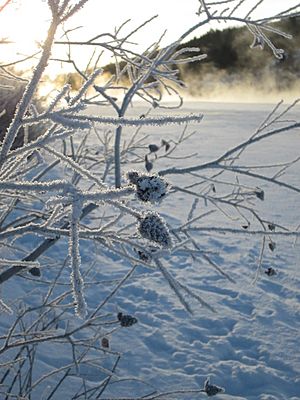
Winters are cold and the air temperature can drop to or below −20 °C (−4 °F) on average of 22 days of the year and −30 °C (−22 °F) on average of 3.7 days of the year, and are often broken up by warm, dry Chinook winds that blow into Alberta over the mountains. These winds can raise the winter temperature by 20 °C (36 °F), and as much as 30 °C (54 °F) in just a few hours, and may last several days. As well, Calgary's proximity to the Rocky Mountains affects winter temperature average mean temperature with a mixture of lows and highs, and tends to result in a mild winter for a city in the Prairie Provinces. Temperatures are also affected by the wind chill factor, Calgary's average wind speed is 14.2kph, one of the highest in Canadian cities.
In summer, daytime temperatures can exceed 30 °C (86 °F) an average of 5.1 days anytime in June, July and August, and occasionally as late as September or as early as May, and in winter drop below or at −30 °C (−22 °F) 3.7 days of the year. As a consequence of Calgary's high elevation and aridity, summer evenings tend to cool off, with monthly averages below 10 °C (50 °F) throughout the summer months.
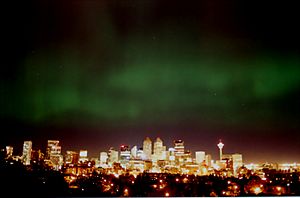
Calgary has the most sunny days year round of Canada's 100 largest cities, with just over 332 days of sun; it has on average 2,396 hours of sunshine annually. With an average relative humidity of 55% in the winter and 45% in the summer (15:00 MST),
Calgary International Airport in the northeastern section of the city receives an average of 418.8 mm (16.49 in) of precipitation annually, with 326.4 mm (12.85 in) of that occurring in the form of rain, and 129 cm (51 in) as snow. The most rainfall occurs in June and the most snowfall in March. Calgary has also recorded snow every month of the year. It is uncommon in July, but not unheard of. The last notable event was on July 15, 1999.
Thunderstorms can be frequent and some times severe with Calgary averaging more than 27 days with thunderstorms, with most of them occurring in the summer months. Calgary lies within Alberta's Hailstorm Alley and is prone to damaging hailstorms every few years. A hailstorm that struck Calgary on September 7, 1991, was one of the most destructive natural disasters in Canadian history, with over $400 million in damage. Being west of the dry line on most occasions, tornadoes are rare in the region.
The highest temperature ever recorded in Calgary was 36.1 °C (97 °F) on July 15, 1919 and July 25, 1933. The coldest temperature ever recorded was −45.0 °C (−49 °F) on February 4, 1893.
| Climate data for Calgary International Airport, 1981–2010 normals, extremes 1881–present | |||||||||||||
|---|---|---|---|---|---|---|---|---|---|---|---|---|---|
| Month | Jan | Feb | Mar | Apr | May | Jun | Jul | Aug | Sep | Oct | Nov | Dec | Year |
| Record high humidex | 17.3 | 21.9 | 25.2 | 27.2 | 31.6 | 33.3 | 36.9 | 36.0 | 32.9 | 28.7 | 22.2 | 19.4 | 36.9 |
| Record high °C (°F) | 17.6 (63.7) |
22.6 (72.7) |
25.4 (77.7) |
29.4 (84.9) |
32.4 (90.3) |
35.0 (95.0) |
36.1 (97.0) |
35.6 (96.1) |
33.3 (91.9) |
29.4 (84.9) |
22.8 (73.0) |
19.5 (67.1) |
36.1 (97.0) |
| Mean daily maximum °C (°F) | −0.9 (30.4) |
0.7 (33.3) |
4.4 (39.9) |
11.2 (52.2) |
16.3 (61.3) |
19.8 (67.6) |
23.2 (73.8) |
22.8 (73.0) |
17.8 (64.0) |
11.7 (53.1) |
3.4 (38.1) |
−0.8 (30.6) |
10.8 (51.4) |
| Daily mean °C (°F) | −7.1 (19.2) |
−5.4 (22.3) |
−1.6 (29.1) |
4.6 (40.3) |
9.7 (49.5) |
13.7 (56.7) |
16.5 (61.7) |
15.8 (60.4) |
11.0 (51.8) |
5.2 (41.4) |
−2.4 (27.7) |
−6.8 (19.8) |
4.4 (39.9) |
| Mean daily minimum °C (°F) | −13.2 (8.2) |
−11.4 (11.5) |
−7.5 (18.5) |
−2.0 (28.4) |
3.1 (37.6) |
7.5 (45.5) |
9.8 (49.6) |
8.8 (47.8) |
4.1 (39.4) |
−1.4 (29.5) |
−8.2 (17.2) |
−12.8 (9.0) |
−1.9 (28.6) |
| Record low °C (°F) | −44.4 (−47.9) |
−45.0 (−49.0) |
−37.2 (−35.0) |
−30.0 (−22.0) |
−16.7 (1.9) |
−3.3 (26.1) |
−0.6 (30.9) |
−3.2 (26.2) |
−13.3 (8.1) |
−25.7 (−14.3) |
−35.0 (−31.0) |
−42.8 (−45.0) |
−45.0 (−49.0) |
| Record low wind chill | −52.1 | −52.6 | −44.7 | −37.1 | −23.7 | −5.8 | 0.0 | −4.1 | −12.5 | −34.3 | −47.9 | −55.1 | −55.1 |
| Average precipitation mm (inches) | 9.4 (0.37) |
9.4 (0.37) |
17.8 (0.70) |
25.2 (0.99) |
56.8 (2.24) |
94.0 (3.70) |
65.5 (2.58) |
57.0 (2.24) |
45.1 (1.78) |
15.3 (0.60) |
13.1 (0.52) |
10.2 (0.40) |
418.8 (16.49) |
| Average rainfall mm (inches) | 0.1 (0.00) |
0.1 (0.00) |
2.2 (0.09) |
10.8 (0.43) |
46.1 (1.81) |
93.9 (3.70) |
65.5 (2.58) |
57.0 (2.24) |
41.7 (1.64) |
7.5 (0.30) |
1.5 (0.06) |
0.3 (0.01) |
326.4 (12.85) |
| Average snowfall cm (inches) | 15.3 (6.0) |
14.5 (5.7) |
22.7 (8.9) |
18.8 (7.4) |
11.9 (4.7) |
0.1 (0.0) |
0.0 (0.0) |
0.0 (0.0) |
3.9 (1.5) |
10.0 (3.9) |
16.6 (6.5) |
15.0 (5.9) |
128.8 (50.7) |
| Average precipitation days (≥ 0.2 mm) | 7.3 | 6.8 | 9.2 | 9.0 | 11.2 | 13.8 | 13.0 | 10.6 | 9.1 | 7.2 | 7.6 | 6.9 | 111.8 |
| Average rainy days (≥ 0.2 mm) | 0.27 | 0.20 | 1.3 | 4.1 | 10.1 | 13.8 | 13.0 | 10.5 | 8.7 | 4.2 | 1.4 | 0.40 | 67.9 |
| Average snowy days (≥ 0.2 cm) | 7.7 | 7.4 | 9.5 | 6.4 | 2.6 | 0.07 | 0.0 | 0.10 | 1.3 | 4.1 | 7.4 | 7.7 | 54.2 |
| Average relative humidity (%) | 54.5 | 53.2 | 50.3 | 40.7 | 43.5 | 48.6 | 46.8 | 44.6 | 44.3 | 44.3 | 54.0 | 55.3 | 48.3 |
| Mean monthly sunshine hours | 119.5 | 144.6 | 177.2 | 220.2 | 249.4 | 269.9 | 314.1 | 284.0 | 207.0 | 175.4 | 121.1 | 114.0 | 2,396.3 |
| Percent possible sunshine | 45.6 | 51.3 | 48.2 | 53.1 | 51.8 | 54.6 | 63.1 | 62.9 | 54.4 | 52.7 | 45.0 | 46.0 | 52.4 |
| Source: Environment Canada | |||||||||||||
| Climate data for University of Calgary, 1971–2000 normals, extremes 1964–1990 | |||||||||||||
|---|---|---|---|---|---|---|---|---|---|---|---|---|---|
| Month | Jan | Feb | Mar | Apr | May | Jun | Jul | Aug | Sep | Oct | Nov | Dec | Year |
| Record high °C (°F) | 16.1 (61.0) |
19.5 (67.1) |
20.5 (68.9) |
28.0 (82.4) |
31.5 (88.7) |
32.2 (90.0) |
33.9 (93.0) |
33.5 (92.3) |
33.9 (93.0) |
28.0 (82.4) |
22.2 (72.0) |
18.0 (64.4) |
33.9 (93.0) |
| Mean daily maximum °C (°F) | −2.6 (27.3) |
−0.7 (30.7) |
3.8 (38.8) |
10.7 (51.3) |
16.0 (60.8) |
20.0 (68.0) |
22.6 (72.7) |
21.7 (71.1) |
16.4 (61.5) |
12.2 (54.0) |
2.9 (37.2) |
−1.7 (28.9) |
10.1 (50.2) |
| Daily mean °C (°F) | −8.1 (17.4) |
−6.2 (20.8) |
−1.7 (28.9) |
4.6 (40.3) |
9.8 (49.6) |
13.9 (57.0) |
16.2 (61.2) |
15.4 (59.7) |
10.3 (50.5) |
6.0 (42.8) |
−2.3 (27.9) |
−6.9 (19.6) |
4.3 (39.6) |
| Mean daily minimum °C (°F) | −13.5 (7.7) |
−11.6 (11.1) |
−7.2 (19.0) |
−1.5 (29.3) |
3.6 (38.5) |
7.7 (45.9) |
9.7 (49.5) |
9.0 (48.2) |
4.2 (39.6) |
−0.3 (31.5) |
−7.5 (18.5) |
−12.0 (10.4) |
−1.6 (29.1) |
| Record low °C (°F) | −40.6 (−41.1) |
−38.0 (−36.4) |
−31.7 (−25.1) |
−20.6 (−5.1) |
−11.1 (12.0) |
−1.5 (29.3) |
0.0 (32.0) |
−2.0 (28.4) |
−10.6 (12.9) |
−24.0 (−11.2) |
−34.0 (−29.2) |
−41.1 (−42.0) |
−41.1 (−42.0) |
| Average precipitation mm (inches) | 17.5 (0.69) |
13.9 (0.55) |
18.7 (0.74) |
29.1 (1.15) |
64.0 (2.52) |
64.4 (2.54) |
66.8 (2.63) |
60.2 (2.37) |
51.8 (2.04) |
14.8 (0.58) |
13.2 (0.52) |
16.5 (0.65) |
430.9 (16.98) |
| Average rainfall mm (inches) | 0.2 (0.01) |
0.1 (0.00) |
1.6 (0.06) |
13.3 (0.52) |
54.9 (2.16) |
64.4 (2.54) |
66.8 (2.63) |
60.2 (2.37) |
47.1 (1.85) |
5.0 (0.20) |
0.6 (0.02) |
0.2 (0.01) |
314.4 (12.37) |
| Average snowfall cm (inches) | 17.3 (6.8) |
13.8 (5.4) |
17.1 (6.7) |
15.8 (6.2) |
9.1 (3.6) |
0.0 (0.0) |
0.0 (0.0) |
0.0 (0.0) |
4.7 (1.9) |
9.7 (3.8) |
12.6 (5.0) |
16.4 (6.5) |
116.5 (45.9) |
| Average precipitation days (≥ 0.2 mm) | 9.1 | 7.8 | 8.1 | 8.0 | 11.5 | 11.9 | 12.6 | 11.3 | 10.2 | 5.4 | 6.8 | 8.1 | 110.8 |
| Average rainy days (≥ 0.2 mm) | 0.40 | 0.05 | 0.85 | 3.7 | 10.5 | 11.9 | 12.6 | 11.3 | 9.6 | 3.0 | 0.68 | 0.42 | 65 |
| Average snowy days (≥ 0.2 cm) | 9.1 | 7.8 | 7.7 | 5.6 | 2.2 | 0.0 | 0.0 | 0.0 | 1.7 | 3.1 | 6.4 | 7.7 | 51.3 |
| Source: Environment Canada | |||||||||||||
Demographics
In the 2021 Census of Population conducted by Statistics Canada, the City of Calgary had a population of 1,306,784 living in 502,301 of its 531,062 total private dwellings, a change of 5.5% from its 2016 population of 1,239,220. With a land area of 820.62 km2 (316.84 sq mi), it had a population density of 1,592.4/km2 (4,124/sq mi) in 2021.
At the census metropolitan area (CMA) level in the 2021 census, the Calgary CMA had a population of 1,481,806 living in 563,440 of its 594,513 total private dwellings, a change of 6.4% from its 2016 population of 1,392,609. With a land area of 5,098.68 km2 (1,968.61 sq mi), it had a population density of 290.6/km2 (753/sq mi) in 2021.
The population of the City of Calgary according to its 2019 municipal census is 1,285,711, a change of 1.4% from its 2018 municipal census population of 1,267,344.
In the 2016 Census of Population conducted by Statistics Canada, the City of Calgary had a population of 1,239,220 living in 466,725 of its 489,650 total private dwellings, a change of 13% from its 2011 population of 1,096,833. With a land area of 825.56 km2 (318.75 sq mi), it had a population density of 1,501.1/km2 (3,888/sq mi) in 2016. Calgary was ranked first among the three cities in Canada that saw their population grow by more than 100,000 people between 2011 and 2016. During this time, Calgary saw a population growth of 142,387 people, followed by Edmonton at 120,345 people and Toronto at 116,511 people.
The Calgary census metropolitan area (CMA) is the fourth-largest CMA in Canada and the largest in Alberta. It had a population of 1,392,609 in the 2016 Census compared to its 2011 population of 1,214,839. Its five-year population change of 14.6 percent was the highest among all CMAs in Canada between 2011 and 2016. With a land area of 5,107.55 km2 (1,972.04 sq mi), the Calgary CMA had a population density of 272.7/km2 (706/sq mi) in 2016. Statistics Canada's latest estimate of the Calgary CMA population, as of July 1, 2017, is 1,488,841.
In 2015, the population within an hour commuting distance of the city was 1,511,755.
As a consequence of the large number of corporations, as well as the presence of the energy sector in Alberta, Calgary has a median family income of $104,530.
The 2021 census reported that immigrants (individuals born outside Canada) comprise 430,640 persons or 33.3% of the total population of Calgary. Of the total immigrant population, the top countries of origin were Philippines (65,430 persons or 15.2%), India (56,515 persons or 13.1%), China (36,240 persons or 8.4%), United Kingdom (20,415 persons or 4.7%), Pakistan (18,375 persons or 4.3%), Vietnam (15,395 persons or 3.6%), Nigeria (12,450 persons or 2.9%), United States of America (10,890 persons or 2.5%), Hong Kong (10,775 persons or 2.5%), and South Korea (8,210 persons or 1.9%).
Ethnicity
According to the 2016 Census, 60% of Calgary's population was of European origin, 4% was of Aboriginal heritage, and 36.2% of the population belonged to a visible minority (that is, non-white, non-aboriginal) group. Among those of European origin, the most frequently reported ethnic backgrounds were British, German, Irish, French, and Ukrainian. Among visible minorities, South Asians (mainly from India and Pakistan) make up the largest group (9.5%), followed by Chinese (6.8%) and Filipinos (5.5%). 5.4% were of African or Caribbean origin, 3.5% was of West Asian or Middle Eastern origin, while 2.6% of the population was of Latin American origin. Of the largest Canadian cities, Calgary ranked fourth in proportion of visible minorities, behind Toronto, Vancouver, and Winnipeg. 20.7% of the population identified as "Canadian" in ethnic origin.
Religion
According to the 2021 census, religious groups in Calgary included:
- Christianity (575,250 persons or 44.5%)
- Irreligion (499,375 persons or 38.7%)
- Islam (95,925 persons or 7.4%)
- Sikhism (49,465 persons or 3.8%)
- Hinduism (33,450 persons or 2.6%)
- Buddhism (20,855 persons or 1.6%)
- Judaism (6,390 persons or 0.5%)
- Indigenous Spirituality (1,370 persons or 0.1%)
- Other (9,695 persons or 0.8%)
Economy
| Industry | Calgary | Alberta |
|---|---|---|
| Agriculture | 6.1% | 10.9% |
| Manufacturing | 15.8% | 15.8% |
| Trade | 15.9% | 15.8% |
| Finance | 6.4% | 5.0% |
| Health and education | 25.1% | 18.8% |
| Business services | 25.1% | 18.8% |
| Other services | 16.5% | 18.7% |
| Rate | Calgary | Alberta | Canada |
|---|---|---|---|
| Employment | 66.9% | 66.3% | 61.2% |
| Unemployment | 10.3% | 9.0% | 6.8% |
| Participation | 74.6% | 72.9% | 65.6% |
Calgary is recognized as a leader in the Canadian oil and gas industry, and its economy expanded at a significantly higher rate than the overall Canadian economy (43% and 25%, respectively) over the ten-year period from 1999 to 2009. Its high personal and family incomes, low unemployment and high GDP per capita have all benefited from increased sales and prices due to a resource boom, and increasing economic diversification.
Calgary benefits from a relatively strong job market in Alberta and is part of the Calgary–Edmonton Corridor, one of the fastest-growing regions in the country. It is the head office for many major oil and gas-related companies, and many financial service businesses have grown up around them. Small business and self-employment levels also rank amongst the highest in Canada. Calgary is a distribution and transportation hub with high retail sales.
Calgary's economy is decreasingly dominated by the oil and gas industry, although it is still the single largest contributor to the city's GDP. In 2006, Calgary's real GDP (in constant 1997 dollars) was CA$52.386 billion, of which oil, gas and mining contributed 12%. The larger oil and gas companies are BP Canada, Canadian Natural Resources Limited, Cenovus Energy, Encana, Imperial Oil, Suncor Energy, Shell Canada, Husky Energy, TransCanada, and Nexen, making the city home to 87% of Canada's oil and natural gas producers and 66% of coal producers.
As of November 2016, the city had a labour force of 901,700 (a 74.6% participation rate) and 10.3% unemployment rate.
In 2013, Calgary's four largest industries by employee count were "Trade" (with 112,800 employees), "Professional, Scientific and Technical Services" (100,800 employees), "Health Care and Social Assistance" (89,200 employees), and "Construction" (81,500 employees).
In 2006, the top three private sector employers in Calgary were Shaw Communications (7,500 employees), Nova Chemicals (4,945) and Telus (4,517). Companies rounding out the top ten were Mark's Work Wearhouse, the Calgary Co-op, Nexen, Canadian Pacific Railway, CNRL, Shell Canada and Dow Chemical Canada. The top public sector employers in 2006 were the Calgary Zone of the Alberta Health Services (22,000), the City of Calgary (12,296) and the Calgary Board of Education (8,000). Public sector employers rounding out the top five were the University of Calgary and the Calgary Roman Catholic Separate School Division.
In Canada, Calgary has the second-highest concentration of head offices in Canada (behind Toronto), the most head offices per capita, and the highest head office revenue per capita. Some large employers with Calgary head offices include Canada Safeway Limited, Westfair Foods Ltd., Suncor Energy, Agrium, Flint Energy Services Ltd., Shaw Communications, and Canadian Pacific Kansas City. CPR moved its head office from Montreal in 1996 and Imperial Oil moved from Toronto in 2005. Encana's new 58-floor corporate headquarters, the Bow, became the tallest building in Canada outside of Toronto. In 2001, the city became the corporate headquarters of the TSX Venture Exchange.
WestJet is headquartered close to the Calgary International Airport, and Enerjet has its headquarters on the airport grounds. Prior to their dissolution, Canadian Airlines and Air Canada's subsidiary Zip were also headquartered near the city's airport. Although its main office is now based in Yellowknife, Canadian North, purchased from Canadian Airlines in September 1998, still maintains operations and charter offices in Calgary.
One of Canada's largest accounting firms, MNP LLP, is also headquartered in Calgary.
According to a report by Alexi Olcheski of Avison Young published in August 2015, vacancy rates rose to 11.5 percent in the second quarter of 2015 from 8.3 percent in 2014. Oil and gas company office spaces in downtown Calgary are subleasing 40 percent of their overall vacancies. H&R Real Estate Investment Trust, which owns the 58-storey, 158,000-square-metre Bow Tower, claims the building was fully leased. Tenants such as Suncor "have been letting staff and contractors go in response to the downturn".
Arts and culture
Calgary was designated as one of Canada's cultural capitals in 2012. While many Calgarians continue to live in the city's suburbs, more central neighbourhoods such as Kensington, Inglewood, Forest Lawn, Bridgeland, Marda Loop, the Mission District, and especially the Beltline, have become more popular and density in those areas has increased.
Stage
Calgary is the site of the Southern Alberta Jubilee Auditorium performing arts, culture and community facility. The auditorium is one of two "twin" facilities in the province, the other is the Northern Alberta Jubilee Auditorium in Edmonton, each being locally known as the "Jube." The 2,538-seat auditorium was opened in 1957 and has been host to hundreds of musical theatre, theatrical, stage and local productions. The Calgary Jube is the resident home of the Alberta Ballet Company, the Calgary Opera, and the annual civic Remembrance Day ceremonies. Both auditoriums operate 365 days a year and are run by the provincial government. Both received major renovations as part of the province's centennial in 2005.
The city is also home to a number of performing arts spaces, such as Arts Commons, which is a 400,000 square foot performing arts complex housing the Jack Singer Concert Hall, Martha Cohen Theatre, Max Bell Theatre, Big Secret Theatre, and Motel Theatre, the Pumphouse Theatre, which houses the Victor Mitchell and Joyce Doolittle theatres, The GRAND, the Bella Concert Hall, the Wright Theatre, Vertigo Theatre, Stage West Theatre, Lunchbox Theatre, and several other smaller venues.
Theatre
Some large theatre companies share Calgary's Arts Commons building, including One Yellow Rabbit, Theatre Calgary, and Alberta Theatre Projects. The Grand is a culture house dedicated to the contemporary live arts. Other companies, groups, and collectives operate in niche theatres, such as Storybook Theatre (children's theatre), Sundog Storytellers (immersive theatre), and The Shakespeare Company.
Calgary is the birthplace of the Theatresports, which are improvisational theatre games.
Music
Every three years, Calgary hosts the Honens International Piano Competition (formerly known as the Esther Honens International Piano Competition). The finalists of the competition perform piano concerti with the Calgary Philharmonic Orchestra; the laureate is awarded a cash prize (currently $100,000.00 CDN, the largest cash award of any international piano competition), and a three-year career development program. Honens is an integral component of the classical music scene in Calgary.
A number of marching bands are based in Calgary. They include the Calgary Round-Up Band, the Calgary Stetson Show Band, the Bishop Grandin Marching Ghosts, and the six-time World Association for Marching Show Bands champions, the Calgary Stampede Showband, as well as military bands including the Band of HMCS Tecumseh, the King's Own Calgary Regiment Band, and the Regimental Pipes and Drums of The Calgary Highlanders. There are many other civilian pipe bands in the city, notably the Calgary Police Service Pipe Band.
Calgary is also home to a choral music community, including a variety of amateur, community, and semi-professional groups. Some of the mainstays include the Mount Royal Choirs from the Mount Royal University Conservatory, the Calgary Boys' Choir, the Calgary Girls Choir, the Youth Singers of Calgary, the Cantaré Children's Choir, Luminous Voices Music Society, Spiritus Chamber Choir, and pop-choral group Revv52.
Dance
The Alberta Ballet is Canada's third-largest dance company. Under Jean Grand-Maître's artistic direction, the Alberta Ballet is at the forefront both at home and internationally. Jean Grand-Maître is well known for his successful portrait series collaborations with pop artists like Joni Mitchell, Elton John, and Sarah McLachlan. The Alberta Ballet resides in the Nat Christie Centre.
Other dance companies include Springboard Performance, which hosts the annual Fluid Movement Arts Festival, Decidedly Jazz Danceworks, which opened its new $25-million facility in 2016 in collaboration with the Kahanoff Foundation, as well as a host of others, including European folk dance ensembles, Afro-based dance companies, and diasporic dance companies.
Film and television
Numerous films have been shot in Calgary and the surrounding area, including The Assassination of Jesse James, Brokeback Mountain, Dances with Wolves, Doctor Zhivago, Inception, Legends of the Fall, Unforgiven, The Revenant, and Cool Runnings. Ghostbusters: Afterlife was filmed in downtown Calgary and Inglewood in 2019. Television shows include Fargo, Black Summer, Wyonna Earp Wild Roses, and The Last of Us.
Print media
The Calgary Herald and the Calgary Sun are the main newspapers in Calgary. Global, City, CTV and CBC television networks have local studios in the city.
Visual art
Visual and conceptual artists like the art collective United Congress are active in the city. There are a number of art galleries in the downtown along Stephen Avenue; the SoDo (South of Downtown) Design District; the 17 Avenue corridor; the neighbourhood of Inglewood, including the Esker Foundation. There are also various art installations in the +15 system in downtown Calgary.
Libraries
The Calgary Public Library is the city's public library network, with 21 branches loaning books, e-books, CDs, DVDs, Blu-rays, audiobooks, and more. Based on borrowing, the library is Canada's second-largest and North America's sixth-largest municipal library. The new flagship branch, the 22,000 m2 (240,000 sq ft) Calgary Central Library in Downtown East Village, opened on November 1, 2018.
Museums
Several museums are in the city. The Glenbow Museum is western Canada's largest and includes an art gallery and First Nations gallery. Other major museums include the Chinese Cultural Centre (at 6,500 m2 (70,000 sq ft), the largest stand-alone cultural centre in Canada), Canada's Sports Hall of Fame (at Canada Olympic Park), The Military Museums, the National Music Centre and The Hangar Flight Museum.
Festivals

Calgary hosts a number of annual festivals and events. These include the Calgary International Film Festival, the Calgary Folk Music Festival, the Calgary Performing Arts Festival (formerly Kiwanis Music Festival), FunnyFest Calgary Comedy Festival, Sled Island music festival, Beakerhead, the Greek festival, Carifest, Wordfest, the Lilac Festival, GlobalFest, Otafest, the Calgary Comic and Entertainment Expo, FallCon, the Calgary Fringe Festival, Summerstock, Expo Latino, Calgary Pride, Calgary International Spoken Word Festival, and many other cultural and ethnic festivals. The Calgary International Film Festival is also held annually as well as the International Festival of Animated Objects.
Calgary's best-known event is the Calgary Stampede, which has occurred each July, with the exception of the year 2020, since 1912. It is one of the largest festivals in Canada, with a 2005 attendance of 1,242,928 at the 10-day rodeo and exhibition.
Arts education
Calgary is also home to several post-secondary institutions that provide credit and non-credit instruction in the arts, including the Alberta University of the Arts (formerly Alberta College of Art and Design), the School of Creative and Performing Arts at the University of Calgary, the Mount Royal University Conservatory, and Ambrose University.
Attractions
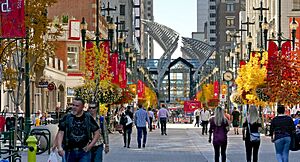
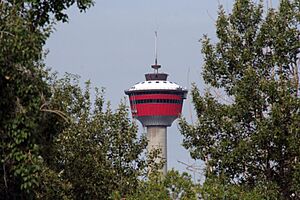
Downtown Calgary features an eclectic mix of restaurants and bars, cultural venues, public squares and shopping. Downtown attractions include the Calgary Tower, Wilder Institute/Calgary Zoo, National Music Centre, Calgary Telus Convention Centre, Chinatown district, Arts Commons, Central Library, St. Patrick's Island, Glenbow Museum, the Art Gallery of Calgary (AGC), Olympic Plaza, the Calgary Stampede grounds and military museums, and various other high rises. Notable shopping areas include the Core Centre, Stephen Avenue and the Eau Claire Market. The Peace Bridge spans the Bow River in the downtown region. The region is also home to Prince's Island Park, an urban park located just north of the Eau Claire district. At 1.0 ha (2.5 acres), the Devonian Gardens is one of the largest urban indoor gardens in the world, located on the top floor of the Core Centre. Directly south of the city's downtown is the Beltline, an urban community known for its bars, nightclubs, restaurants, and shopping venues. At the Beltline's core is 17 Avenue SW, the community's primary entertainment and nightlife strip, lined with a high concentration of bars and entertainment. During the Calgary Flames' Stanley Cup run in 2004, 17 Avenue SW was frequented by over 50,000 fans and supporters per game night. The concentration of red jersey-wearing fans led to the street's playoff moniker, the "Red Mile". Downtown Calgary is easily accessed using the CTrain transit system with 9 train stations in the city's downtown core. The train is also fare-free while downtown.
Attractions in other areas of the city include the Heritage Park Historical Village, depicting life in pre-1914 Alberta and featuring working historic vehicles such as a steam train, paddle steamer and electric streetcar. The village itself comprises a mixture of replica buildings and historic structures relocated from southern Alberta. Just west of the city limits is Calaway Park, Western Canada's largest outdoor family amusement park, and just north of the park across the Trans Canada Highway is the YBV Springbank Airport, where the Wings over Springbank Airshow is held every July. Other major city attractions include Canada Olympic Park (which features Canada's Sports Hall of Fame) and Spruce Meadows. On top of the many shopping areas in the city centre, there are a number of large suburban shopping complexes in the city. Among the largest are Chinook Centre and Southcentre Mall in the south, Westhills and Signal Hill in the southwest, South Trail Crossing and Deerfoot Meadows in the southeast, Market Mall in the northwest, Sunridge Mall in the northeast, and the newly built CrossIron Mills and New Horizon Mall just north of the Calgary city limits, and south of the City of Airdrie.
Sports and recreation
Within Calgary, there are approximately 8,000 ha (20,000 acres) of parkland available for public usage and recreation. These parks include Fish Creek Provincial Park, Inglewood Bird Sanctuary, Bowness Park, Edworthy Park, Confederation Park, Prince's Island Park, Nose Hill Park, and Central Memorial Park. Nose Hill Park is one of the largest municipal parks in Canada at 1,129 ha (2,790 acres). The park has been subject to a revitalization plan that began in 2006. Its trail system is currently undergoing rehabilitation in accordance with this plan. The oldest park in Calgary, Central Memorial Park, dates back to 1911. Similar to Nose Hill Park, revitalization also took place in Central Memorial Park in 2008–2009 and reopened to the public in 2010 while still maintaining its Victorian style. An 800 km (500 mi) pathway system connects these parks and various neighbourhoods. Calgary also has multiple private sporting clubs including the Glencoe Club and the Calgary Winter Club.
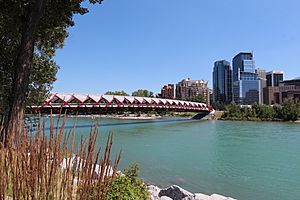
In large part due to its proximity to the Rocky Mountains, Calgary has traditionally been a popular destination for winter sports. Since hosting the 1988 Winter Olympics, the city has also been home to a number of major winter sporting facilities such as Canada Olympic Park (bobsleigh, luge, cross-country skiing, ski jumping, downhill skiing, snowboarding, and some summer sports) and the Olympic Oval (speed skating and hockey). These facilities serve as the primary training venues for a number of competitive athletes. Also, Canada Olympic Park serves as a mountain biking trail in the summer months. Calgary unsuccessfully bid to host the 2026 Winter Olympics, losing to Milan/Cortina Italy.
In the summer, the Bow River is frequented by river rafters and fly-fishermen. Golfing is also an extremely popular activity for Calgarians, and the region has a large number of courses. The Century Downs Racetrack and Casino is a 5+1⁄2-furlong (1.1 km) horse track located just north of the city.
As part of the wider Battle of Alberta, the city's sports teams enjoy a popular rivalry with their Edmonton counterparts, most notably the rivalries between the National Hockey League's Calgary Flames and Edmonton Oilers, and the Canadian Football League's Calgary Stampeders and Edmonton Elks.
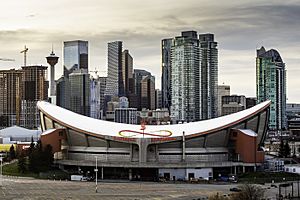
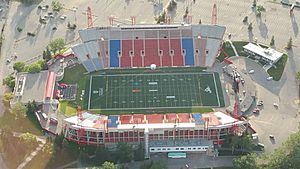
Calgary is the hometown of the Hart wrestling family and the location of the Hart family "Dungeon", where the patriarch of the Hart Family, Stu Hart, trained numerous professional wrestlers including Superstar Billy Graham, Brian Pillman, the British Bulldogs, Adam Copeland, Christian Cage, Greg Valentine, Chris Jericho, Jushin Thunder Liger and many more. Also among the trainees were the Hart family members themselves, including WWE Hall of Fame member and former WWE champion Bret Hart and his brother, the 1994 WWF King of the Ring, Owen Hart.
Notable sporting events held by Calgary include:
- 1972 World Figure Skating Championships
- 1985 IBF World Championships
- 1995 World Junior Ice Hockey Championships (co-hosted with Edmonton and Red Deer), 2012 World Junior Ice Hockey Championships (co-hosted with Edmonton)
- 1997 World Police and Fire Games
- FIBT World Championships 2005
- 2006 World Figure Skating Championships
- 2007 North American Outgames
- 2008 IIHF World Women's U18 Championship
- 2009 Water Ski World Championships
- 2021 Women's Ice Hockey World Championships
- 2023 World Junior Figure Skating Championships
| Club | League | Venue | Established | Championships |
|---|---|---|---|---|
| Calgary Stampeders | Canadian Football League | McMahon Stadium | 1945 | 8 |
| Calgary Flames | National Hockey League | Scotiabank Saddledome | 1980 | 1 |
| Calgary Roughnecks | National Lacrosse League | Scotiabank Saddledome | 2001 | 3 |
| Cavalry FC | Canadian Premier League | ATCO Field | 2018 | 1 |
| Calgary Wranglers | American Hockey League | Scotiabank Saddledome | 2022 | 0 |
| Calgary Surge | Canadian Elite Basketball League | Winsport Arena | 2023 | 0 |
| Calgary RATH | National Ringette League | Winsport Arena | 2007 | 3 |
| Calgary Wild FC | Northern Super League | McMahon Stadium | 2025 | 0 |
| Club | League | Venue | Established | Championships |
|---|---|---|---|---|
| Calgary Canucks | Alberta Junior Hockey League | Henry Viney Arena | 1971 | 9 |
| Calgary Hitmen | Western Hockey League | Scotiabank Saddledome | 1995 | 2 |
| Calgary Mavericks | Rugby Canada National Junior Championship | Calgary Rugby Park | 1998 | 1 |
| Prairie Wolf Pack | Canadian Rugby Championship | Calgary Rugby Park | 2009 | 1 |
| Calgary Rage | Western Women's Canadian Football League | Shouldice Athletic Park | 2009 | 0 |
Infrastructure
Transportation
Public transit
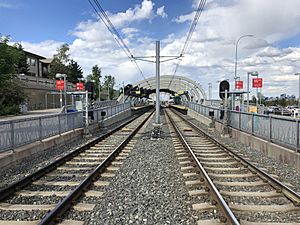
Calgary Transit provides public transportation services throughout the city with regular bus service, bus rapid transit (BRT), and light rail transit (LRT). Calgary's light rail system, known as the CTrain, was the second light rail system in North America (behind the Edmonton LRT). It currently consists of two lines (Red Line and Blue Line), with 44 stations and 58.2 km (36.2 mi) of track. Most of the CTrain runs on both dedicated tracks with partial grade separation across suburban areas, and a street-level section across downtown. The CTrain is North America's second busiest LRT system, carrying 270,000 passengers per weekday and approximately half of Calgary downtown workers take the transit to work. The CTrain is also North America's first and only rapid transit system to run on 100% renewable, wind-generated energy. In early 2020, city council approved construction of the Green Line, the third light rail line in the city's rapid transit network. It will be the first rail line in Calgary to operate low-floor trains and is the largest public works project in the history of Calgary, about three-and-a-half times bigger than the second-largest project.
Airports
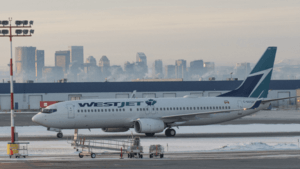
Calgary International Airport (YYC), in the city's northeast, is a major transportation and cargo hub for much of central and western Canada. It is Canada's fourth busiest airport, serving 18 million passengers in 2019. The airport serves as the primary gateway into Banff National Park, located 90 minutes west, and the entire Canadian Rocky Mountain Parks system. Non-stop destinations include cities throughout Canada, the United States, Europe, Central America, and Asia. Calgary/Springbank Airport, Canada's eleventh busiest, serves as a reliever for the Calgary International taking the general aviation traffic and is also a base for aerial firefighting aircraft.
Pedestrian and cycling
Spanning over 1,000 km (620 mi), Calgary has the most extensive walking and cycling pathway network in North America. There are also 290 km (180 mi) of on-street bikeways and 96 km (60 mi) of publicly maintained trails. As of 2017, 140,000 Calgarians cycle at least once a week and about 400,000 cycle occasionally. 40% of cyclists in Calgary ride no matter how cold it gets and 96% ride when temperatures are above 0 °C. The Peace Bridge provides pedestrians and cyclists access to the downtown core from the north side of the Bow River. The bridge ranked among the top 10 architectural projects in 2012 and among the top 10 public spaces of 2012.
Skyway
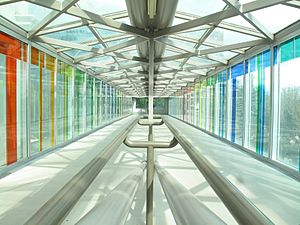
In the 1960s, Calgary started to develop a series of pedestrian bridges connecting many downtown buildings.
Today, these bridges connect between most of the city's downtown office towers and make up the world's most extensive skyway network (elevated indoor pedestrian bridges), officially called the +15. The system shields pedestrians from the city's extremely cold winter temperatures. The name derives from the fact that the bridges are usually 4.6 m (15 ft) above ground.
Roads and highways
Calgary lies at the crossroads of Highway 2 and the Trans-Canada Highway, making it an important hub for the transit of goods across Canada and along the CANAMEX Corridor. Stoney Trail encircles the city, completing a full ring road. The last segment in west Calgary was completed in December 2023, and is now open to the public. Freeways and expressways are mostly called "trails". Highway 2, named Deerfoot Trail, is the main north–south route through Calgary and one of the busiest highways in Canada. Much of Calgary's street network is on a grid where roads are numbered with avenues running east–west and streets running north–south. Until 1904 the streets were named; after that date, all streets were given numbers radiating outwards from the city centre. Roads in predominantly residential areas, as well as freeways and expressways, do not generally conform to the grid and are usually not numbered. However, it is a developer and city convention in Calgary that non-numbered streets within a new community have the same name prefix as the community itself.
Rail
Calgary's presence along the Canadian Pacific Kansas City mainline (which includes the CPKC Alyth Yard) makes the city an important hub of freight rail throughout the province. There is no inter-city or regional passenger rail serving the city. In June 2020, the Canada Infrastructure Bank signed a memorandum of understanding with the Government of Alberta to build a 130-kilometre (81 mi) inter-city rail line from downtown Calgary to Banff, and an express line from Calgary International Airport to downtown Calgary. A 350–400 km/h (220–250 mph) high-speed rail line running from Downtown Calgary to Downtown Edmonton is planned as well. In July 2021, EllisDon signed a memorandum of understanding with the Government of Alberta to build the line, and it is expected to open sometime between 2030 and 2032.
Between 1955 and 1978, CPR operated a transcontinental passenger rail service called the Canadian, running between Toronto and Vancouver via CPR's right-of-way through Calgary. In 1978, Via Rail assumed responsibility over CPR's Canadian rail service. In the aftermath of another round of deep budget cuts made to Via Rail on January 15, 1990, Via permanently discontinued the Super Continental and rerouted the Canadian along the Super Continental's CN route, bypassing Regina and Calgary in favour of Saskatoon and Edmonton. Since then, there has been no intercity rail service to or from Calgary. But two new rail-tour lines have opened along the CPR right-of-way: Rocky Mountaineer and Royal Canadian Pacific. The latter still operates rail-tour services to Calgary, while the former has terminated its westbound services at Banff, two hours to the west.
Education
Primary and secondary
In the 2011–2012 school year, 100,632 K-12 students enrolled in 221 schools in the English language public school system run by the Calgary Board of Education. With other students enrolled in the associated CBe-learn and Chinook Learning Service programs, the school system's total enrolment is 104,182 students. Another 43,000 attend about 95 schools in the separate English language Calgary Catholic School District board. The much smaller Francophone community has their own French language school board (The Southern Francophone Education Region No. 4), which is also based in Calgary, but serves a larger regional district. There are also several public charter schools in the city. Calgary has the country's first high school exclusively designed for Olympic-calibre athletes, the National Sport School. The oldest school in Calgary that is still in operation is St. Mary's High School. Calgary is also home to many private schools including Mountain View Academy, Rundle College, Rundle Academy, Clear Water Academy, Calgary French and International School, Chinook Winds Adventist Academy, Webber Academy, Delta West Academy, Masters Academy, Calgary Islamic School, Menno Simons Christian School, West Island College, Edge School, Calgary Christian School, Heritage Christian Academy, and Bearspaw Christian School.
Calgary is also home to what was Western Canada's largest public high school, Lord Beaverbrook High School, with 2,241 students enrolled in the 2005–2006 school year. Currently the student population of Lord Beaverbrook is 1,812 students (September 2012) and several other schools are equally as large; Western Canada High School with 2,035 students (2009) and Sir Winston Churchill High School with 1,983 students (2009).
Post-secondary
The publicly funded University of Calgary (U of C) is a research university. It is Calgary's largest degree-granting post-secondary institution, with an enrolment of approximately 34,000 students in 2022. Mount Royal University, with over 14,000 students, grants degrees in a number of fields. SAIT Polytechnic, with over 14,000 students, provides polytechnic and apprentice education, granting certificates, diplomas and applied degrees. Athabasca University provides distance education programs. Both SAIT and the University of Calgary have CTrain light-rail stations on or near their campuses.
Other publicly funded post-secondary institutions based in Calgary include the Alberta University of the Arts, Ambrose University (associated with the Christian and Missionary Alliance and the Church of the Nazarene), Bow Valley College, and St. Mary's University. The publicly funded Athabasca University, Northern Alberta Institute of Technology (NAIT), and the University of Lethbridge also have campuses in Calgary.
Several independent private institutions are in the city. These include ABM College, Alberta Bible College, CDI College, Columbia College, MaKami College, Reeves College, Robertson College, and Sundance College.
Media
Calgary's daily newspapers include the Calgary Herald, and Calgary Sun, and formerly StarMetro.
Calgary is the sixth largest television market in Canada. Broadcasts stations serving Calgary include CICT 2 (Global), CFCN 4 (CTV), CKAL 5 (City), CBRT 9 (CBC), CKCS 32 (YesTV), and CJCO 38 (Omni). Network affiliate programming from the United States originates from Spokane, Washington.
There are a wide range of radio stations, including a station for First Nations and the Asian Canadian community.
Notable people
International relations
The City of Calgary maintains trade development programs, cultural and educational partnerships in twinning agreements with six cities:
| City | Province/State | Country | Date |
|---|---|---|---|
| Quebec City | Quebec | Canada | 1956 |
| Jaipur | Rajasthan | India | 1973 |
| Daqing | Heilongjiang | China | 1985 |
| Naucalpan | Mexico State | Mexico | 1994 |
| Tarui | Gifu | Japan | 1996 |
| Daejeon | Daejeon | South Korea | 1996 |
| Phoenix | Arizona | US | 1997 |
Calgary is one of nine Canadian cities, out of the total of 98 cities internationally, that is in the New York City Global Partners, Inc. organization, which was formed in 2006 from the former Sister City program of the City of New York, Inc.
See also
 In Spanish: Calgary para niños
In Spanish: Calgary para niños


